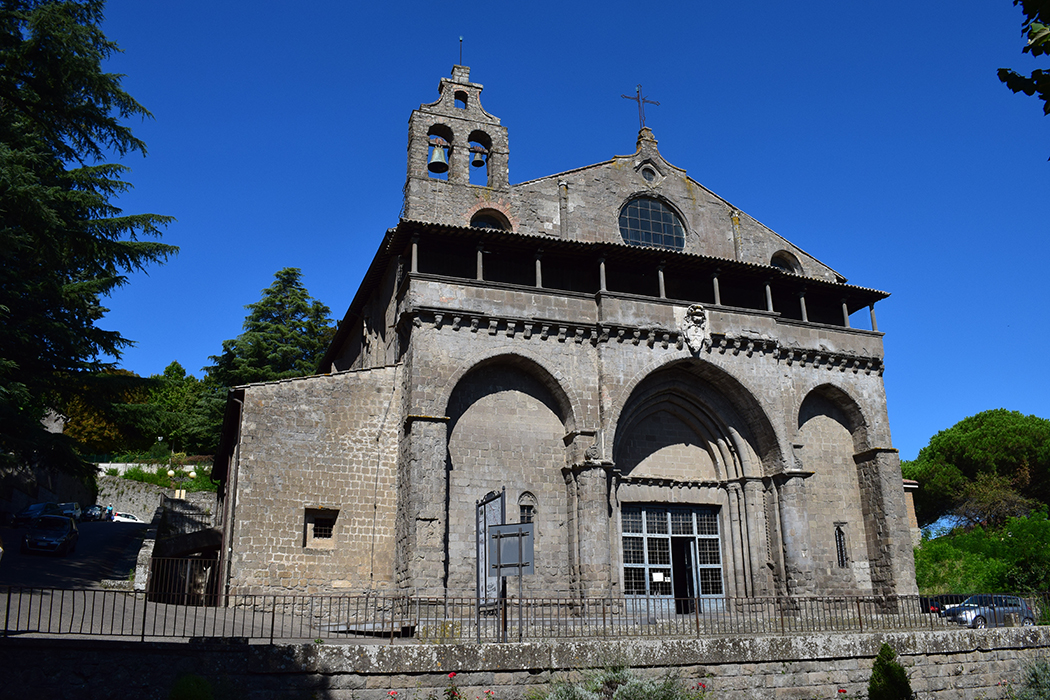The splendid church of Saint Flavian (San Flaviano) is located outside the town of Montefiscone along the ancient route of the Via Francigena and takes its name from a Christian martyr who lived at the time of Emperor Julian the Apostate and who was the husband of Santa Dafrosa and father of the saints Bibiana and Demetria.
Flavian had been a Roman aristocrat and a prefect under Constantine and was then enslaved after his conversion to Christianity.
Probably Flavian had arrived as a slave in this area to work on the construction of a temple.
The church is very old and there is a trace of a first building already existing in 850 because it is mentioned in a document by Pope Leo IV.
The church is very special because today it is composed of the superimposition of two different buildings, both with three naves but with opposite orientation that exploit the difference in height of the ground. The lower church is the oldest and dates back to 1032 and was built by Lombard masters in Romanesque-Gothic style.
In reality, even the oldest church was based on a central Romanic nucleus that somehow recalled the architecture of the Holy Sepulchre of Jerusalem. In the past, Montefiascone had been very important because it was the point where the different pilgrim routes met that were leading to Rome.
On one side Via Francigena and on the other the Via Roma that came from the Adriatic and the Baltics, and the road that arrived from Bologna.
In the fourteenth century the church was enlarged and the current façade was completed, characterized by a final platform with three large arches, in the central one 0f which there is the coat of arms of Cardinal Aldovrandi and the glass door leading to the church.
Above these arches there is a small loggia that partially hides the final part of the church. The façade ends with three circular openings at the aisles and a bell gable with two bells.
The interior of the church has a local square stone cladding that is frescoed in many parts with works from the fourteenth and sixteenth centuries.
The columns that divide the three naves have capitals very different from each other, some in Romanesque and other Byzantine according to the period in which they were made, and the church ends with three apses of which the central one has a fresco of the fifteenth century that represents Christ enthroned between Saint Peter and Saint Paul.
Immediately below this fresco of the apse stands an image of St. Flavian on horseback and the altar that houses his relics.
At the centre of the church a large ceiling opening connects the two religious buildings and from the top you can have a view of the lower one as on a balcony.
The upper church can be reached through an internal staircase that is at the end of the right aisle, or from the upper road that connects with the centre of Montefiascone. In the upper church is the throne of Pope Urban IV who had consecrated the altar in 1262.
The exterior facade of this church is totally different and has a style of early baroque with a large rose window with 4 lobes and two side doors with an oval window above.
The Frescoes of Saint Flavian
The lower church presents an incredible cycle of frescoes of refined beauty executed between the fifteenth and sixteenth centuries.
They narrate biblical events of the New Testament such as the Cradle, the Epiphany and the Annunciation and stories of the life of saints such as Saint Catherine of Alexandria and Saint Nicholas of Bari.
Particular attention is deserving of the encounter between "Three Alive and Three Dead" which is located above the arch of the first chapel in the left aisle. In an ornate frame is the phrase "Think about what you are and what you can not avoid becoming".
Among other images of saints we recognize Santa Barbara, Saint Sebastian.
Defuk's tomb
Among the chapels of the church of Saint Flavian one deserves particular attention: it is that of the bishop Johannes Defuk (Giovanni Fugger) who died in 1113 but who in a certain sense still influences the history of Montefiascone.
A legend tells that the bishop was in the team of Emperor Henry V who went to Rome to be crowned by Pope Pasquale II. The bishop loved wine a lot and told one of his servants to precede him and taste the wine in the various taverns.
In order to communicate with the bishop, the servant Martin had to write the Latin word EST! On the door of the taverns that served a good wine.
Arrived in Montefiascone, delighted by the local wine called moscatello, the servant wrote three times the word Est! Est!! Est!!!
It is then said that the bishop decided to stop in Montefiascone on his return journey and to have enjoyed so much wine and company to stay here until his death.
The bishop also left an inheritance to be able to celebrate every year a festival dedicated to wine.
Johannes Defuk is buried in the church of San Firmino under a beautiful inlaid slab and a plaque recalls his story with the words: "East est est pr nim est hic Jo De Fuk do meus mortuus est" which stands for "Est est est propter nimium est hic Johannes De Fuk dominus meus mortuus est" (For too much EST! here lies my lord Johannes Defuk).
A legend tells us that Defuk left a legacy to the 24,000 Roman shields to organize a large wine party on his grave on August 24, the day of San Bartolomeo, patron of the seminary.







Follow us